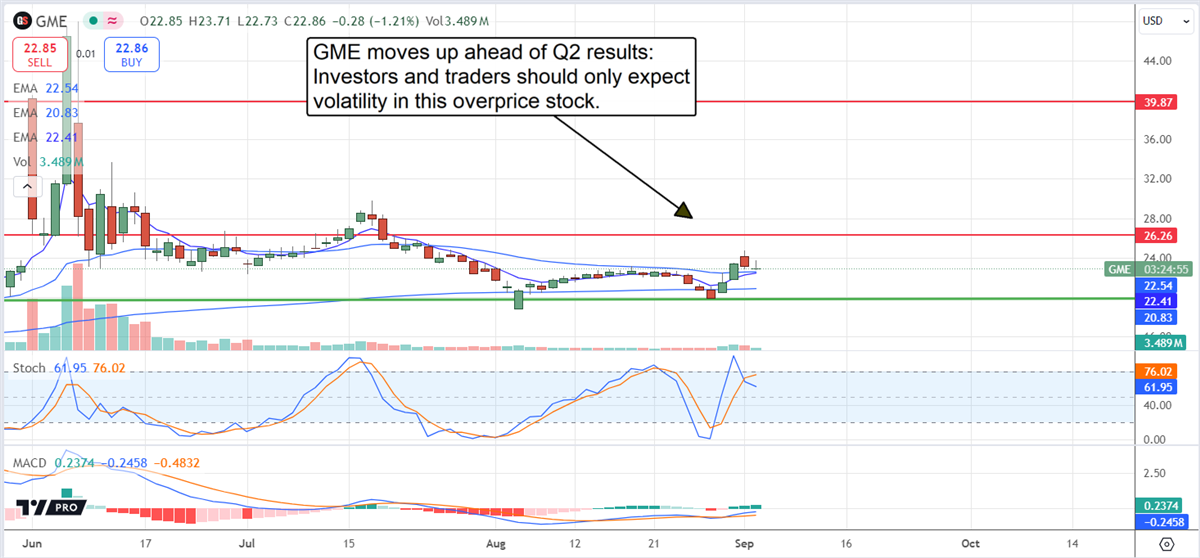GameStop Stock: Time to Buy or Brace for a Post-Earnings Drop?
2024.09.06 09:56
- GameStop is moving up from a bottom and may move higher. Investors are cautioned to avoid this stock, and traders should be cautious.
- The Q2 results will likely disappoint the market because the consensus is overly optimistic.
- Short-sellers are covering today, but are likely to reposition if the price surges again and bog down the market if results fail to impress.
GameStop (NYSE:) shares are up more than 17% from the late-August low, confirming support at a critical level, and they may head higher. Is this stock buyable at these levels? The answer is maybe, but it depends on your risk tolerance and expectations.
Given the recent results, there has been no shift in fundamental quality or hope for one. Investors should stay on the sidelines and enjoy the show because the upcoming earnings release will likely provide one. Volatility, price swings, and knee-jerk reactions are the most likely outcomes for this retail stock, and they are the purview of speculators and traders.
GameStop Will Likely Miss Consensus Forecasts When It Reports
Only a few analysts cover GameStop, so conviction in the consensus figures is low. However, the consensus is optimistic, expecting a sequential improvement in results and only a 22% decline compared to last year. The consensus is optimistic because the core Hardware and Software segments contracted by 50% sequentially in the previous quarter and 30% compared to last year, and the Collectibles segment contracted by 42% and 20%. No change or improvement is expected this quarter.
The decline in Collectibles is most significant because collectibles were supposed to be the company’s saving grace, reinvigorating growth and driving profits. The reality is that collectibles helped to bloat an aging inventory and are now a dead weight for the business. Inventories have come down from their peak, but even that is not great news. The inventory reduction in Q1 was insufficient to drive profitability, and that dynamic may have worsened due to the extreme contraction in core business.
There Is Little Sell-Side Support for GameStop: Only High Short-Interest
GameStop still has plenty of support from retail traders, but its sell-side support is virtually nonexistent, suggesting the upward price movement is unsustainable. The single analyst firm to rate the stock is Wedbush, which has it pegged at Sell. Their last update came after the Q1 release and was a price target reduction pointing to a 50% downside compared to the current price action.
Institutional activity is more supportive but insufficient to drive share prices significantly higher. Institutions have bought on balance in Q2 and Q3, increasing their net position to about 30% of the stock but still a low figure. The purchases are likely speculative and likely offset by options trades or short sales, and more likely to drive volatility than not.
Short covering reduced short interest to about 10% in the last report. It aids upward drift in the price action ahead of the Q2 release but is unlikely to evaporate soon. Investors and traders should expect the short-sellers to reposition at higher price points if the Q2 release sparks a rally and to bog down the market with shares if it doesn’t.
GameStop’s Share Count Surge: Can the Stock Rise Despite Dilution?
GameStop is well-capitalized and likely to report more than $2.5 billion on its balance sheet, but it comes at a cost. The company leaned hard into share sales earlier this year and significantly increased the share count by roughly 25%, and it may do so again if shares spike. The reason is that it is still losing money and needs capital to sustain operations and enable its next evolution if there is another evolution for this business.
The price action shows a bottom for the stock near $20, and upward movement is indicated by stochastic and MACD. However, the stock is trading within a range with robust overhead due to the meme-driven price pop in May and June. The critical resistance targets are $27.50 and $30, possibly hit before the Q3 results are released, and $40, which may be reached after the release if there is even a kernel of good news. The risk for traders is not getting out when the chance is presented because it may only come once, assuming the price will increase.
Another risk is that price action will fall below $20 and revert to the $10 range from whence it came, which is the more likely scenario. Trading at nearly $25, it is trading at nearly 5x book while slowly eating itself to death. 
Original Post








